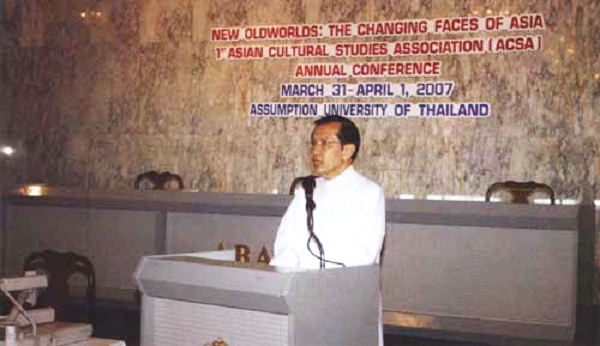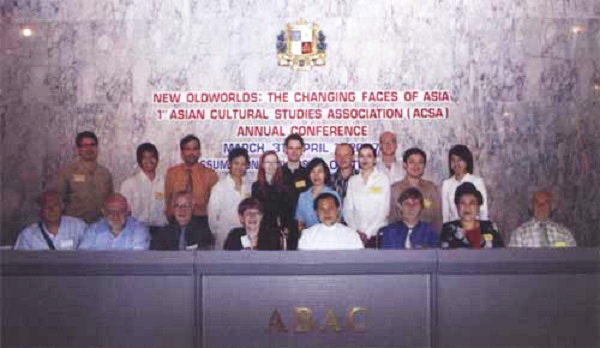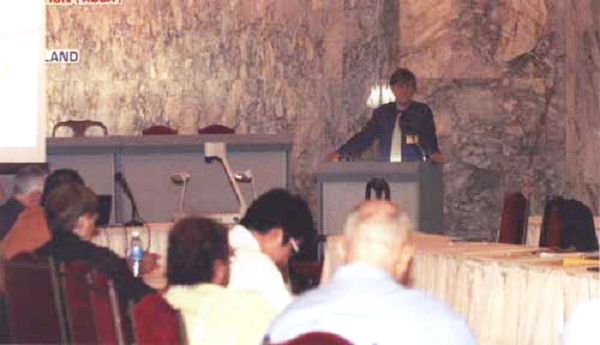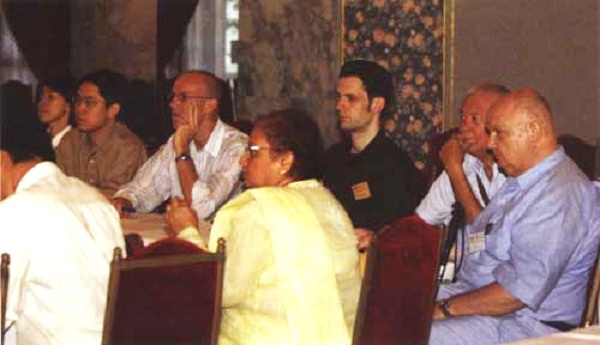Opening Address: ACSA Conference, March 31, 2007, Hall of Fame
Dr. Bancha Saenghiran giving the lecture at the Hall of Fame on March 31, 2007 At Assumption University.
Dear organizers, presenters and participants of this, the first Asian Cultural Studies Association annual conference. First & foremost, allow me to welcome foreign participants to Thailand, welcome to AU & to this Conference:
It is my pleasure to deliver the opening address to this conference which is entitled “New Old Worlds: The Changing Faces of Asia”.
Today, I would like to talk about the themes of this conference by considering the key words in its title: [“new”, “old”, “worlds”, “change”, “face(s)”, and “Asia”.] And I would like to consider the meaning of these terms in the context of a larger important question that I believe is implicit in the title of this conference. The question is, I think: “What is Asia now? What does it look like?” These are two important questions that we as teachers in universities must understand and answer. If we can do these things then we may teach our students not only about the new ideas in business and science, but the old ideas that have made us culturally who we are today.
As you are already aware, we in Asia are in a rapidly changing environment, and this is true not only for our economies and our societies, out also for our universities. As we in the university work to fulfill our mission of helping our societies develop new and effective responses to these changes, we should remember that we do so as part of a dynamic and fluid process. This process must focus on the ways we develop new perspectives on who we are and what we are doing.
The question of new perspectives and what these perspectives will look like, I believe, is central to the continued success of the university in Asia.
To understand what we should be, we also need to look back at what we have been in the past. We need to see what in that past we can use to help us in the future. To understand where we come from helps us to understand where we now are. We should remember our roots and traditions, the things that make us who we are.
These are important for a number of reasons. Without them, we will be rudderless in the sea of changes that may otherwise sweep us away in the increasingly competitive and complex world in which we live. We cannot simply change our face every time we face a new difficulty or challenge. Nor can we attempt to transform ourselves as others may want us to do … at least not without asking ourselves whether we are doing so while remaining true to ourselves.
Instead, we must try to understand that the new technologies and sciences that seem to come predominantly from the U.S. and from Europe, come with their own traditions and multiple pasts. Those in the West understand that vibrant past well and can tap into it so as to adapt themselves and grow within those pasts, those old worlds.
However, we in Asia have our own “old worlds” too. This means that for us here, we have to look not at one old world but at two old worlds: the Western and our own Asian one.
In the West, the term “new world” was first coined by the Europeans to refer to the Americas. Shakespeare has his character Miranda says, “Oh brave new World” in The Tempest. The term seemed appropriate then in the early seventeenth century … the wonder of that new world, the Americas, with its offer of a new start and new opportunities clearly affected the Europeans in their “old world”. But then, we must also remember that Shakespeare’s new world became Huxley’s Brave New World in the nineteen thirties … not a utopia, but a dystopia, a nightmare where unthinking abuses of technology and dehumanized philosophy run amok to the detriment of the society they were originally designed or meant to help.
Is this change in the meaning of the phrase “brave new world” significant? The OLD meaning of hope is transformed into a new meaning: one of despair. A de-humanized world that has forgotten its traditions and reasons for being should not be the world we teach our students to accept.
For us in Asia, we need to ask are we the new “brave new world” as seen from Europe and America? Do we see these new forces of modernity as our own versions of a “brave new world” as Shakespeare saw that world … or as Huxley saw it?
We should also remember that for many, we in Asia are “the new world”. When we look around at our cities and our enterprises, we certainly can understand such a perception. A new world of opportunities and hope, of change and development: that is usually how we look at ourselves. The dynamism and productivity that characterize our own enterprise has already transformed our societies in ways unimagined by those who went before us, by our ancestors.
Dr. Bancha Saenghiran together with lecturers from the department of English promotion
attending the meeting to discuse the Shakespeare, Confusion and Huxley.
Would they recognize this new world we have built for ourselves in Asia? If we have successfully managed to preserve our traditions and our roots, if we have successfully defined ourselves in our own, specifically Asian terms, then those who went before us very well may recognize us. But if we haven’t so maintained our face…? Then, I suppose, we would be unrecognizable to our ancestors. They would not recognize our faces now.
And, equally importantly: if we have forgotten how to look at our old, past life, then we would not be able to recognize heir faces or ourselves in those faces.
Confucius once said “He who by re-animating the Old can gain knowledge of the New is fit to be a teacher” (Analects, II, 11). These words were spoken over 2,500 years ago by a philosopher in Wei, a dukedom in what was not yet China. He seems to have anticipated the theme of this Asian Cultural Studies Association conference by 2,500 years. To make the old worlds new, to re-animate ourselves, to give our past new life: these are the concerns as I understand them of a humanities-based approach to understanding the challenges and opportunities of those studying the world in Asia and who want to understand how we in Asia see things in our world. Without this skill to re-animate our past, we may lack the ability to express who we really re. This mistake could lead us away from the Shakespearean vision of the new world and towards Huxley’s nightmare of that new world.
I just mentioned Confucius. He is what we now call “Chinese”, while many of us in this room are not Chinese. But this need not concern us too much. If we can understand that Confucius’s words still speak to us in the twenty-first century in Thailand, then we have evinced the skill I have already mentioned: we have managed to build a bridge between us and so taken a step along the way to self-enunciation of who we are and, more importantly, who we want to be.
This brings me back to the association, Asian Cultural Studies Association (ACSA), which we have launched here at Assumption University. This association is, I believe, the f?rst of its kind in Asia in that this association seeks to bring together academics and others who practice the liberal arts so that they can dialogue about what it means to be in Asia at this exciting time in our world.
Our Asian faces or identities are multi-faced. To study this quality and to explore what this means to us can best be done in a multi-disciplinary way. The papers at this conference are not from only one field. They come from teachers, philologists, business writers, film-studies students, architects, sociologists etc.
The task as I see it, is to put these many different faces together in a multi-cultural, multi-disciplinary dialogue so that we can see ourselves from many different angles and through many different eyes. By understanding how the Thais, Chinese, Pakistanis, Indians, Singaporeans, Japanese, Koreans, Europeans, and other westerners who are presenting papers at this conference see Asia and its faces, we may come to see ourselves in a “New” way while also insisting on the validity of our own “Old” faces and ways.
By putting these two faces together, we are simultaneously doing something that seems to be characteristic of Asian cultures in general. That is, we are insisting on an understanding of our traditions and cultures in their own terms; we are seeing that our old or past worlds are still with us. They are alive and well. The vibrancy with which these faces and worlds are articulated in conferences and associations such as the ones we are welcoming here today are strong indicators of the good health of our universities and academics
Dr. Stephen Conlon of the department participating in the discussion on the subject after
Dr. Bancha Saenghiran has completed the lecture.
here in Asia. This vibrancy is also evidenced, I might add in passing, by the fact that we at Assumption University are also launching today a new journal: the Asian Journal of Literature, Culture and Society. This journal too may become a “new face” in Asia: one that gives voice to the different ways of seeing Asian and its many varied pasts as somehow similar while recognizing the powerful differences or varieties of those pasts and traditions.
If we are to manage how we change ourselves and how we are changed by others, we need to understand how we have changed and been changed in the past and BY that past. That is why conferences, associations and journals such as those I have just been mentioning are important.
Over the past few decades, with the explosion of new ideas and forces of technology and science, we in Asia may have advanced in many spectacular ways. This is testimony to the power of science and the skills of those in Asia to adopt, adapt and change those forces to our own advantage. This is the face of Asia seen by the rest of the world.
But there is another face: the one of the traditional Asia that we have grown up with and which has made us who we are.
This “Old” face of Asia has not as yet received the emphasis it deserves by us … at least not when we compare our emphasis of it with the emphasis we have placed on the more scientific aspects of our cultures and societies. Yet,, if we are to shape all of these new economic and scientific forces to address the issues that are important to us here in Asia, we should try to do so in our own way.
What this “new” way may be has yet to be determined. One may suggest that if it is to be characteristically Asian then it will have a poly-synchronic aspect. What this means is that our way of defining our faces, our pasts and our new worlds will be more than one thing at the same time. In other worlds: there is more than one face to Asia, just as there is more than one Asian face. Against the stereotypes that we may sometimes fall into, we should always try to emphasize the variety of experience and cultures that together comprise Asia. This is the task of the humanities which hopefully have some important things to contribute to the development of the new old faces of Asia along side the images of that world that business, silence and technology have so far given us.
The one thing that such a humanities-based approach offers that is not offered by the sciences is a sense of the past and how our cultures have important things to say to us as we shape our modern world here in Asia. This cultural face of Asia when seen together with the technological face of Asia may be put together so as to express the qualities of Asian learning, thinking and experience in new holistic way. The two faces need to be complementary, not necessarily antagonistic.
The old and the new, the past and the present, Shakespeare / Confucius and Huxley, Confucius and technology, Thailand and China, Japan and India, science and the humanities: all of these permutations are Western and Asian, similar and different.
Our task as academics working in Asia is to put all of these things together. By doing this we may well define who we are and what we have to say that makes us specifically Asian in this global village. This putting together of things that up to now have all too often been forgotten or even ignored may very well help us to understand better who we really are and what we have to say to each other both here in Asia and in the West.
This new dialogue between cultures in Asia about what it means to be culturally aware of Asian in Asia is yet another aspect of the role of the University as a source not only of traditional knowledge and identity but also of new knowledge and new identities. We must make our own images of ourselves by giving space to those who have other ways of studying themselves and the world.
There is more than one way to do these things. And it is my hope that through conferences such as this and
A group of lecturers discussed Dr. Bancha Saenghiran’s talk after the delivery of the lecture.
through associations such as the Asia Cultural Studies Association, new opportunities are created for understanding and explaining ourselves to each other and to the rest of the world.
It is through such activities as you are about to embark on here today that we may “re-animate the Old” and so gain new knowledge of the past as well as of the new worlds we have developed in modern Asia.
At this point I would like to close my remarks by returning to where I began. Our new and old faces must be put together so that we can see ourselves in our complexity and in multi-sensory, multi-disciplinary ways. We must be open to other faces and cultures. And these cultures should be Asian as well as Western.
If we can do this, then perhaps we will be able to teach our students about what it means to be Asian in this “brave new word” we are making in our own image. We can reanimate the past and change our present by expressing these different qualities of our own societies. This is what fits us to be good teachers.
But to say this is not to say something necessarily “new”. It has been part of our cultural knowledge for thousands of years. What is new is the way we express this knowledge in our current environments in our universities and societies. Our universities must have at least two faces: the old and the new: the cultural and the technological: the scientific and the humanistic faces of the university as a force for change AND traditions.
To “re-animate” our old worlds through our arts and cultures will make us better understand what we are doing with our new technologies and sciences. We preserve our past by reinvigorating it, re-interpreting it in light of who we are now. In this way, we can be better teachers of both the can be better teachers of both the new and the old.
Honored Guests, Ladies & Gentlemen:
Welcome to Assumption University, where the East and West meet. And in particular, welcome to the first Asian Cultural Studies Association (ACSA) Annual Conference (2007). Wish you every success in this Conference.
May God bless you all and thanking you for listening
แหล่งที่มา : ABAC TODAY (Vol. 22 No. 1 January-March 2007) หน้า 11-14





